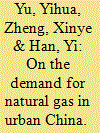|
|
|
Sort Order |
|
|
|
Items / Page
|
|
|
|
|
|
|
| Srl | Item |
| 1 |
ID:
090111


|
|
|
|
|
| Publication |
2009.
|
| Summary/Abstract |
In the published literature, the differences in environmental performance across countries are typically explained using the Environmental Kuznets Curve. The Environmental Kuznets Curve states that pollution initially increases with economic growth. Once GDP per capita reaches a certain level, the relationship reverses. In the present paper, we provide an alternative hypothesis, where budget structure plays an important role in explaining the variations in pollution across the world: the lower the business-related taxes as a share of total tax revenue, the higher the property tax in total tax revenue and the higher the ratio of public health expenditure in total expenditure, then the stronger the incentive of pollution control and the lower the pollution level. Our empirical findings reveal that the budget structure does have an important impact on pollution control. The policy implication of this research is that effective control of environmental pollution requires changes in tax structure and expenditure assignment. This research has important policy implications for China's tax system reform and pollution control efforts.
|
|
|
|
|
|
|
|
|
|
|
|
|
|
|
|
| 2 |
ID:
124561


|
|
|
|
|
| Publication |
2013.
|
| Summary/Abstract |
This study employs spatial panel techniques to examine determinants of regional allocation of infrastructure investment made by the central government. Using a sample of 31 Chinese provinces over the 2001-2008 period, we derived four major empirical findings. First, there exist substantial spatial interactions of central government's investment across regions. Second, the central investment exhibits a highly persistent effect. Third, the central government attempts to balance equity and efficiency in its decision-making. Last, the political factor plays a significant role in the regional infrastructure investment.
|
|
|
|
|
|
|
|
|
|
|
|
|
|
|
|
| 3 |
ID:
136208


|
|
|
|
|
| Summary/Abstract |
A comprehensive survey of 1450 households in 26 Chinese provinces was undertaken in 2012 to identify the characteristics and potential driving forces of residential energy consumption in China. The survey covers six areas: household characteristics, dwelling characteristics, kitchen and home appliances, space heating and cooling, residential transportation, and electricity billing, metering, and pricing options. The results show that a typical Chinese household in 2012 consumed 1426 kilograms standard coal equivalent, which is approximately 44 percent of the 2009 level in the United States and 38 percent of the 2008 level in the EU-27. District heating, natural gas, and electricity are three major residential energy sources, while space heating, cooking, and water heating are three major end-use activities. Moreover, the results suggest a large urban–rural gap in terms of energy sources and purpose of usage. Commercial energy is used mainly for space heating in urban areas, while biomass dominates mainly for cooking purpose in rural areas. The survey results can help decision makers and scholars identify energy conservation opportunities, and evaluate the effectiveness of energy policies.
|
|
|
|
|
|
|
|
|
|
|
|
|
|
|
|
| 4 |
ID:
150720


|
|
|
|
|
| Summary/Abstract |
China’s residential electricity demand has grown rapidly over the last three decades and given the expected continued growth, demand side management (DSM) can play an important role in reducing electricity demand. By using micro-level data collected from 1450 households in 27 provinces in the first-ever China Residential Energy Consumption Survey in 2012, this study estimates the effects of three DSM measures empirically: tiered household electricity pricing, China Energy Label program, and information feedback mechanisms. We find these measures have contributed to moderating residential electricity demand growth but additional policy reform and tools are needed to increase their effectiveness and impact. Residential electricity demand is found to be price- and income- inelastic and tiered pricing alone may not be as effective in electricity conservation. The statistically significant relationship between China Energy Label efficient refrigerators - but not televisions - and lowered residential electricity consumption reflect mixed program effectiveness. Lastly, of the information feedback currently available through electricity bills, payment frequency and meters, only meter reader is estimated to be statistically significant. Important policy implications and recommendations for improving each of these three DSM measures to expand their impact on reducing residential electricity consumption are identified.
|
|
|
|
|
|
|
|
|
|
|
|
|
|
|
|
| 5 |
ID:
192335


|
|
|
|
|
| Summary/Abstract |
Challenges coexist with opportunities for achieving carbon neutrality through power sector reform. Based on the ongoing reform in China and generator-level data in 2019, we identify three channels through which the reform could affect carbon emissions. We analyze the theoretical mechanisms under a long-term average cost competition framework, evaluate the emission reduction potentials of the three channels, explore the obstacles in achieving these potentials, and propose corresponding solutions. We find the following: (1) By reshaping the generation competition between high-efficiency and low-efficiency coal-fired generators, the reform has the potential to reduce carbon emissions by 205.4 million tons. However, considering the high financial costs of high-efficiency generators, realizing the full potential is difficult. (2) Administrative promotion of renewable energy could reduce carbon emissions by 311 million tons, but with large implicit expenses, which makes the promotion unsustainable. (3) The price dividend induced by the reform could increase carbon emissions by 98.1 million tons. To achieve emission reduction potentials in the first two channels and offset the rebound effect in the third channel, we propose explicitly pricing carbon. Without other supporting measures, a carbon price of over 400 Chinese yuan per ton of carbon dioxide is essential for the reform to eliminate barriers to its implementation.
|
|
|
|
|
|
|
|
|
|
|
|
|
|
|
|
| 6 |
ID:
182809


|
|
|
|
|
| Summary/Abstract |
The loss of targeting efficiency due to information asymmetry is a longstanding problem in aid programs. China's Targeted Poverty Alleviation (TPA) program addresses this problem by assigning local government officials to individual impoverished households. These officials, referred to as poverty alleviation coordinators (PACs), are required to pay frequent home visits to the assigned households and to deploy policy resources for poverty reduction. The program is costly in terms of human resources because the officials also have regular duties in a variety of departments. We investigate the effects of the PAC system on poverty alleviation and explore the mechanisms of the effects. Based on the Chinese Poor Population Tracking Dataset and econometric analysis, we find that the households with a larger income increase are those whose PACs work in a department that has the type of resources needed by the household. This indicates that a good match between the resource and the need could enhance the effect of the TPA program. In addition, PACs at a higher position in the governance structure show a larger income increase in their assigned households, which is expected, because a higher position could have more resources to deploy. These findings shed light on role of institutional arrangements in alleviating information asymmetry in poverty reduction programs.
|
|
|
|
|
|
|
|
|
|
|
|
|
|
|
|
| 7 |
ID:
132747


|
|
|
|
|
| Publication |
2014.
|
| Summary/Abstract |
Using a set of unbalanced panel data for Chinese×s cities during the period of 2006-2009, this study aims to estimate the price and income elasticities of residential demand for natural gas. Natural gas consumption is specified as a function of its own price; substitute prices; urban wages; and other supply, climate, and housing characteristics. Using a feasible generalised least squares (FGLS) technique, which controls for panel heteroskedasticity and panel correlation, we find that natural gas consumption is price elastic and income inelastic when other covariates (e.g., the supply of natural gas pipeline and heating degree days) are controlled. In addition, there are large variations in demand behaviours across China×s regions. There is a substantial income effect on demand for natural gas in southern China, whereas the northern regions are found to have a higher price effect. In addition, the substitution effect between coal and natural gas is significant in North China but is not significant in South China. These findings have several important policy implications for natural gas pricing and supply cost analysis in the context of China.
|
|
|
|
|
|
|
|
|
|
|
|
|
|
|
|
| 8 |
ID:
114794


|
|
|
|
|
| Publication |
2012.
|
| Summary/Abstract |
In China, the responsibility of protecting the environment lies largely with local governments. Within the framework of spatial econometrics, we investigate empirically the consequence of such an institutional setting. Using city-level data for China, the present study finds that city governments behave strategically in making spending decisions regarding environmental protection. This paper finds that a city government appears to cut its own spending as a response to the rise in environmental protection spending by its neighbors. Hence, environmental protection tends to be underprovided. As a result, we suggest that centralizing the environmental protection responsibility to a higher level of government would be beneficial in terms of controlling pollution in China.
|
|
|
|
|
|
|
|
|
|
|
|
|
|
|
|
| 9 |
ID:
116961


|
|
|
|
|
| Publication |
2012.
|
| Summary/Abstract |
We employ decomposition analysis and econometric analysis to investigate the driving forces behind China's changing energy intensity using a provincial-level panel data set for the period from 1995 to 2009. The decomposition analysis indicates that: (a) all of the provinces except for a few experienced efficiency improvement, while around three-fourths of the provinces' economics became more energy intensive or remained unchanged; (b) consequently the efficiency improvement accounts for more than 90% of China's energy intensity change as opposed to the economic structural change.
The econometric analysis shows that the rising income plays a significant role in the reduction of energy intensity while the effect of energy price is relatively limited. The result may reflect the urgency of deregulating the price and establishing a market-oriented pricing system in China's energy sector. The implementation of the energy intensity reduction policies in the Eleventh Five-Year Plan (FYP) has helped reverse the increasing trend of energy intensity since 2002. Although the Chinese Government intended to change the industry-led economic growth pattern, it seems that most of the policy effects flow through the efficiency improvement as opposed to the economic structure adjustment. More fundamental changes to the economic structure are needed to achieve more sustainable progress in energy intensity reduction.
|
|
|
|
|
|
|
|
|
|
|
|
|
|
|
|
|
|
|
|
|